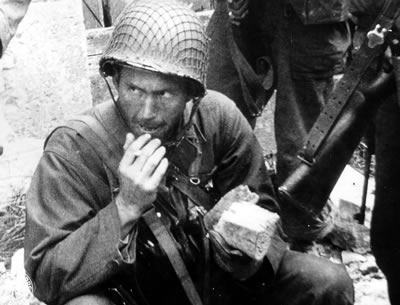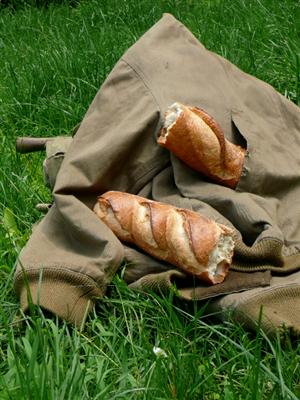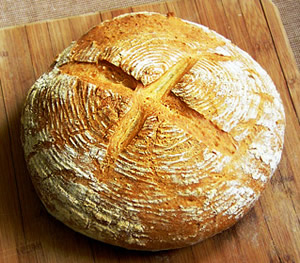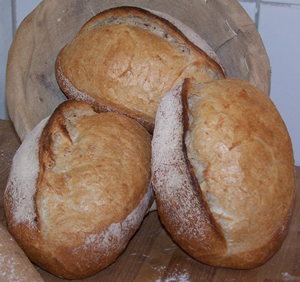Non Ration Foodstuffs: Normandy
Published: Winter, 2010
Author: Charles McFarlane
90th IDPG
Preface
Lets face it - we dont always have the time, resources or motivation to put together our own Reproduction K Rations, 10 in 1's or other "issue" rations. A common work around is for reenactors to go out and get "civilian" food and try and pass it off as an authentic alternative to K Rations. The issue with grabbing just any old thing from the grocery store is that it falls into stereotypes and lacks the academic rigor that is demonstrated on K Rations or any other item of our impression. Would you go out and get "any old helmet" or "any old pair of boots" and wear them to an event - so why would you just grab some "french bread" and "cheese" and think its "authentic".
Just as we focus our impressions on specific units during specific actions or periods of the war, we must also focus what we eat as part of the overall impression. We spend so much time on the pattern and stitch level construction of garments, small parts on weapons, the color and texture of our helmets - why would it be OK for us to eat just any old wine, bread or cheese?
There are several approaches to sourcing civilian food: fresh perishable foods, non-perishable canned goods, complete prepared meals. Each approach has its own advantages and disadvantages. Canned goods, while easily available at any store - may be more difficult to find period correct sized and styled cans, as well as correct period labels. Complete prepared meals raise a series of logistical issues of transportation, food safety and preparation. For the scope of this article, I will be covering fresh perishable foods.
Photo from the Normandie Archive
A GI eating what appears to be a large slice of a Miche / Pan de Campagne
Bread
Bread is versatile, it can be eaten alone, with cheese, made into a sandwich, or eaten with rations. The most “iconic” and undenyably French bread would be the baguette. The baguette as we know it today, unchanged from the 1940's was conceived in the 1920’s as a result of French law.
"It is forbidden to employ workers at bread and pastry making between ten in the evening and four in the morning”
-Bulletin des Lois de la République Française - Nouvelle Série -- Année 1919 T.XI:241-264 B. No 246 (p.769) - No 13950-
French law forbade bakers and bakery workers to start work before 4 am, thus not allowing enough time to make dough, proof and fully bake thicker round loaf types before customers would arrive in the morning. The first loaves of the day would be baguettes - while other types like boule and miche would be ready later in the day.
Thus, the symbol of French bread was born. GI's quickly formed their own opinions and slang for the Baguette in typical GI style. Whether it was the phallic resemblance of the long thin golden tan loaf or a social commentary, some GI's came to know the Baguette as "cock sucker bread"*.
-* Page: 36, FUBAR; Soldier Slang of World War Two by Gordon L. Rottman, Osprey publishing.
What to look for in a baguette
Baguettes should be about 24 inches long, slit across the top with a golden slightly shiny hard crispy crust. Baguettes should be made from plain white flour and not whole grain or multi grain. The bread should be fully baked - stay away from the take and bake style unless you intend to finish baking the bread at home yourself.
Where to get a baguette
Most bakery sections of your local super market should have reasonable baguettes. If not, check Whole Foods or a simliar type of store - or Panera Bread.
Other types of bread
To avoide the cliches and stereotypes associated with baguette - there are numerous other types of bread that were and are available and historically correct. Most notably are boule or pain de campagne.
Boule - this is just a generic type of bread referring to the shape. This is a round loaf of white bread taking its name from the fact that its made from a simple ball of dough.
Photo from The Sun Blog
Pain de Campagne - translating to "Bread of Champagne" from its regional heritage was found throughout France by WWII. This is a simple round or oval loaf ("miche") usually made from multiple grain types - or simply whatever was available on hand. This is a traditional country bread that is naturally leavened through wild yeast rather than commercial leavening. This is similar to some american sourdough breads in consistency and flavors. It would not be uncommon to find loaves made with with multiple coarsely ground grain types, including rye flour and wood flour.
When looking for pain de campagne style miches, rustic and whole grain are your two keys to success
Photo from techno.boulangere.free.fr
France "suffered" under the German occupation and subesquent rationing, where much of the available flour was diverted to production of bread for the German Army. In typical German fashion, ersatz flour substitutes were imposed to fill the gap.
I note "suffered" as a relative term, as things were much, much worse elsewhere - even within the borders of Germany.
“As the war raged on, the German government required that the flour sold to civilians contain increasing amounts of wood flour. Sometimes a local hausfrau would run out as we passed and give us a loaf of her freshly baked bread. Always there would be a warning not to eat it immediately as it would cause some indigestion. I assumed it was because the wood flour was much slower in absorbing moisture than wheat flour and continued to do so for several days after baking. If eaten too soon, the absorption of moisture took place in the digestive tract and could cause indigestion. But we always ate it immediately and never noticed any problems. “
Frank Wayne Martin, Private First Class, Forward Observer for General Patton
Photo from the Normandie Archive
On to page 2 - Fruit
90th
IDPG Research







